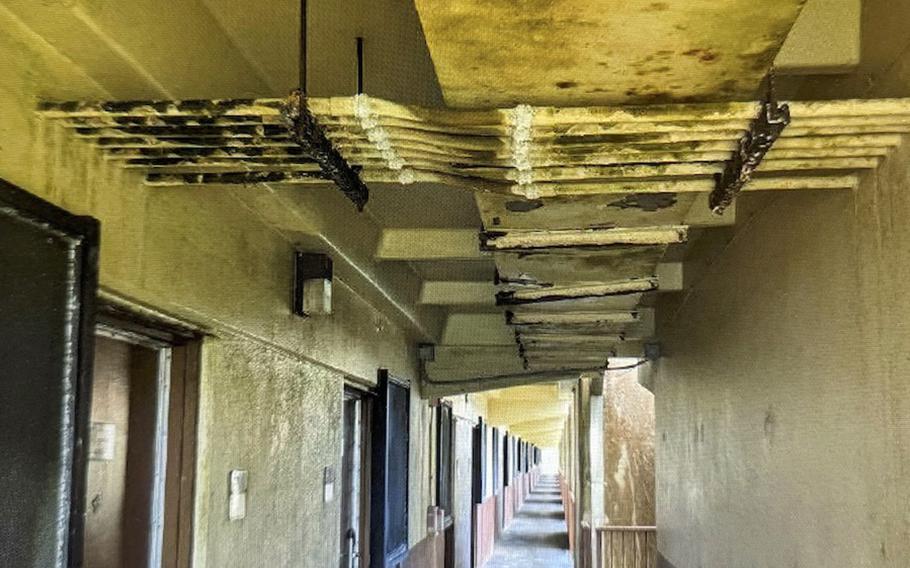
Problems at Palau Hall barracks on Guam include exposed wires, corroded plumbing, deteriorating walls and mold that had been painted over, according to the Project on Government Oversight. ()
Major problems with Guam housing prompted the Navy secretary to open new barracks ahead of schedule and triggered a worldwide review of Navy housing conditions, according to a report released this week by a government watchdog.
Secretary of the Navy John Phelan visited Andersen Air Force Base’s Palau Hall barracks during a May 1-2 trip to the U.S. territory.
He was left “appalled” and “very upset” by what he saw, including exposed electrical wires, corroded plumbing, deteriorating walls and mold that had been painted over, according to the Washington, D.C.-based Project on Government Oversight.
The barracks was housing sailors assigned to a helicopter squadron temporarily operating from Andersen, René Kladzyk, senior investigator on the report, told Stars and Stripes by email Thursday.
Phelan’s visit prompted him to order new bachelor enlisted quarters on Marine Corps Base Camp Blaz to open about a month ahead of schedule, he told the nonprofit watchdog.
The 300-room facility, initially set to open in June, was directed to begin housing service members by May 16, Marine Corps Headquarters spokeswoman Capt. Brenda Leenders told Stars and Stripes in a May 20 email.
As of May 22, 25 Marines and 48 sailors had been relocated from Palau Hall, according to the report.

Problems at Palau Hall barracks on Guam include exposed wires, corroded plumbing, deteriorating walls and mold that had been painted over, according to the Project on Government Oversight. (Project on Government Oversight)
The poor conditions also led to a fleetwide directive to inspect all Navy unaccompanied housing, according to a May 5 email from Vice Adm. Scott Gray to Navy leadership, cited by the watchdog group. He described the living conditions as “clearly way outside any reasonable standard” and said they reflected a failure of leadership across multiple levels.
Gray, head of Navy Installations Command, wrote it was “baffling to discover Sailors living in these conditions,” which he described as “clearly way outside any reasonable standard” and lacking “any sense of ownership or responsibility by the facility operators for the welfare of the tenants.”
He ordered inspections of all single-sailor housing to be completed by May 28. However, a spokesperson for Naval Installations Command told the watchdog that some regions may need more time to conduct thorough reviews.
Attached to Gray’s email were photos showing issues inside Palau Hall. One image of exposed wiring, he noted, depicted a room that had been assigned just two weeks earlier.
“The scope of this disrepair includes, but is not limited to the Palau building,” he wrote. “That said, Andersen Sailors reside in no less than four different buildings — none of which are acceptable by today’s living standards.”
An Air Force spokesperson told the watchdog the service is committed to providing safe housing but cited Guam’s harsh, corrosive environment as a contributing factor to infrastructure deterioration.
“Unfortunately, in Guam, we face several environmental elements, and the harsh conditions accelerate the rate at which materials deteriorate and reduce their overall lifespan,” the spokesperson said, according to the report.
A Navy officer formerly stationed on Guam told the watchdog they were not surprised by the conditions, saying: “If you’re living on base, you’re going to be in crappy quarters.”
The officer also expressed concern that the housing inspections could amount to a box-checking exercise.
Phelan told the watchdog that years of deferred infrastructure spending had created serious maintenance backlogs. He said he is committed to ensuring Navy housing is “acceptable.”
The findings align with a September 2023 report by the Government Accountability Office, which found some U.S. military barracks posed “serious health and safety risks,” including sewage overflow, mold, mildew, and broken windows and locks.
Thursday’s watchdog report also cited funding from President Donald Trump’s “One, Big Beautiful Bill,” which allocated $1 billion for barracks maintenance and upgrades across all military branches, with an additional $230 million earmarked for Marine barracks.
However, the watchdog questioned whether that funding would be sufficient. The Air Force alone, it said, faces a $49.5 billion maintenance and repair backlog, citing service official Michael Saunders.